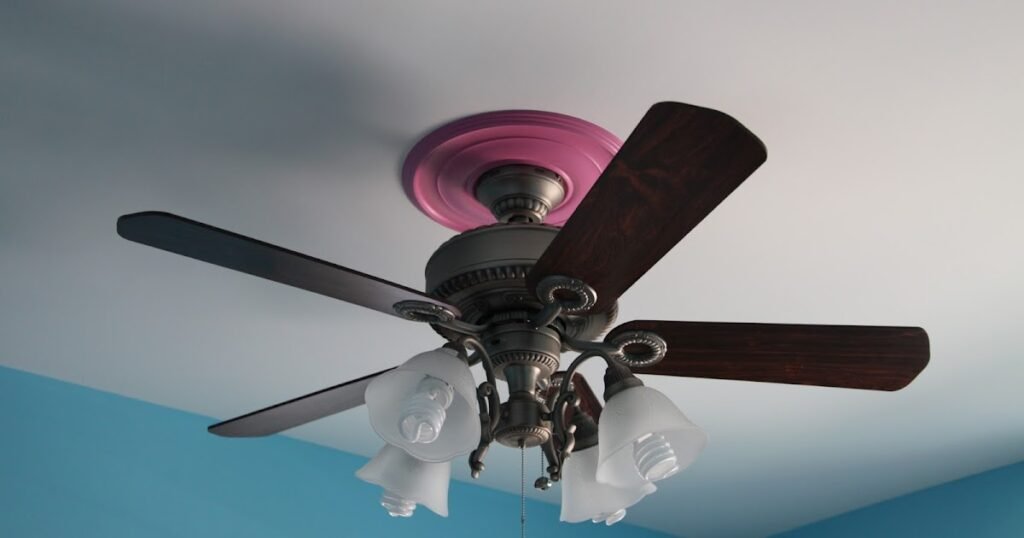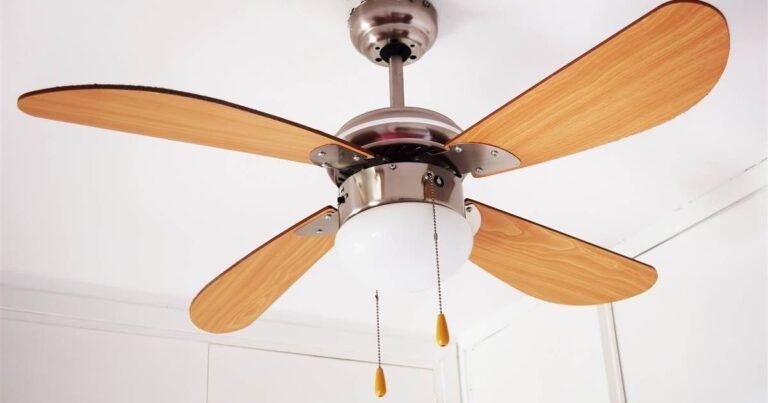Ceiling fans are a common choice to cool homes, providing energy efficient and economical alternatives to air cooling. However, knowing their power usage of devices can benefit consumers make better decisions regarding their energy use and the potential savings. This article delved into the issue of “How many watts is a ceiling fan?” by examining the various factors that affect wattage, typical ranges, energy-efficient choices, and much more.
Understanding Ceiling Fan Power Consumption
The power consumption of ceiling fans can be measured as Watts (W). The power consumption of a ceiling fan shows the amount of electricity it consumes. This is essential to knowing the efficiency of energy and costs associated with operating the fan. In contrast to air conditioners, ceiling fans do not cool the air, they circulate it instead in a way that creates a wind-chill result that helps the surroundings appear more cool.

Factors Influencing Ceiling Fan Wattage
Blade Size and Number
The number and size of blades that a ceiling fans has can significantly affect the power. Fans with larger blades typically require greater power to run. This is due to the fact that they have to move a larger amount of air. That requires more energy. In contrast, smaller fans with smaller blades generally use less energy.
Motor Efficiency
The performance of the motor within the ceiling fan plays an important role in the overall power consumption. High-efficiency motors, like ones that use DC (Direct Current) technology, use less power than conventional AC (Alternating Current) motors. DC motors are able to reduce the power consumed by as much as 70%, which makes them a popular choice among environmentally conscious consumers.
Fan Speed Settings
Ceiling fans have several speed settings, generally that range from low to high. The power consumption of the fan varies based of the settings for speed. When the speed is higher the fan consumes greater power, whereas when it is running at lower speed, it uses less. Knowing how different speeds impact wattage could benefit in managing energy consumption definitely.
Common Wattage Range for Ceiling Fans
The power of ceiling fans can differ widely depending on their design, size and design. The most common the wattage ranges are:
- Minimal Ceiling Fans (29-36 inches): These fans typically consume between 10 and 30 watts at low settings, and up to 50 watts at high settings.
- Medium-sized Ceiling Fans (42-48 inches): These fans typically use between 15 and 40 watts at low settings, and up to 75 watts at high settings.
- Large ceiling fans (52-56 inches): These fans generally consume between 20 and 50 watts at low settings, and as high as 100 watts in high settings.
It is important to keep in mind that these figures may differ according to the fan’s design as well as the efficiency of the motor, among other factors.
Energy-Efficient Ceiling Fans
The efficiency of ceiling fans’ energy use is becoming increasingly important to those seeking to lower their electricity bill and their environmental footprint. Energy-efficient ceiling fans are engineered to help in providing the same cooling effect, but with less energy. Here are some characteristics you should look for in a ceiling fan with energy efficiency:
- Energy Star rating: Fan models with the Energy Star rating comply with the strict guidelines for energy efficiency that are set by the Environmental Protection Agency (EPA). They typically consume 20% to 30 percent less energy than standard models.
- DC Motors Like we said earlier DC motors are more efficient than conventional AC motors. They provide higher efficiency with quieter operation as well as more control over the speed settings.
- The LED lighting: If the ceiling fan has an illumination fixture, going for LED lighting can improve the efficiency of your energy. LEDs use less energy and also last longer as compared to incandescent lights.
Calculating Energy Usage and Costs
The power consumption of the ceiling fan is the beginning. In order to get a full understanding of the impact it has on your electricity bill you must calculate the energy consumption and the cost. Here’s how to calculate it:
- Find out the Wattage Find the power of your ceiling fan according to the specifications of the manufacturer.
- The estimated daily use Calculate the number of hours per day you utilize the fan.
- Calculate daily energy consumption: Divide the fan’s wattage times the amount of time it’s employed every day. This will give you the daily consumption of watts.
- Change to Kilowatt Hours (kWh): Since electricity is charged in Kilowatt-hours Divide the consumption of watts per day by 1,000.
- estimate monthly usage Divide the day’s usage of kWh by 30 to determine an estimate of the usage for one month.
- Calculate the cost: Multiply the monthly consumption of kWh by the current electricity cost (in dollars per kWh).
For instance, if are together a fan that consumes 50 watts, and operates for six hours per day and your electricity cost at $0.12 each kWh
- Daily consumption 50 W six hours equals 300 Wh
- Daily kWh: 300 Wh/ 1,000 = 0.3 Kilowatts
- Monthly use: 0.3 kWh x 30 days = 9 kWh
- Monthly cost 9 kWh 9 kWh x $0.12/kWh = $1.08
Conclusion
Knowing the wattage of ceiling fans is vital in regulating power consumption and reducing electric costs. Ceiling fans typically consume between 10 and 100 watts, dependent the size of their fan, efficiency of motor and speed settings. High-efficiency models, with features like DC lights and motors that use LEDs are able to drastically reduce the power use. Through calculating energy consumption and expenses, customers are able to make informed choices about their cooling options and maximize their energy usage. If you choose the correct ceiling fans, it’s possible to have a comfortable experience while reducing environmental impacts and also reducing the cost of energy.
FAQs
The power that a ceiling fans produces may typically be found in specifications of the product provided from the company that manufactures it. The information could be found on on the fan or in the user’s manual. If you don’t see the information, you can ask the manufacturer directly to obtain the information.
Yes it is true that running a ceiling fan at various speeds can affect its energy consumption. Higher speeds typically improve the amount of watts consumed however, lower speeds lessen the amount of energy consumed. To save energy it is recommended to run the fan at a lower speed, which will still grant adequate cooling.
Ceiling fans are much more efficient in comparison with other options for cooling, such as air conditioners. A typical ceiling fan consumes between 10 and 100 watts, air conditioners consume between 500 and 4000 watts, based on their size and effectiveness. The use of ceiling fans with air conditioners may benefit decrease the energy usage by permitting you to increase the temperature.
Absolutely, together the ceiling fan could benefit lower your consumption of energy. Because they create the sensation of cooling ceiling fans help make higher temperature settings more comfortable, which can reduce the requirement for air cooling. This can result in substantial savings in energy, particularly during the summer months.
If you are looking for an energy-efficient ceiling fan, take into consideration the following aspects:
Energy Star Rating: Check that your fan has been Energy Star certified.
DC Motor Select fans that have DC motors to get better performance.
Lights from LEDs: Find fans equipped with LED light sources if illumination is required.
Reversible Motor The reversible engine allows for the motor to operate both in winter and summer which improves energy efficiency throughout the year.
Multiple Speed Settings Find fans equipped with many speed settings that allow you to manage the power consumption more energetically.

